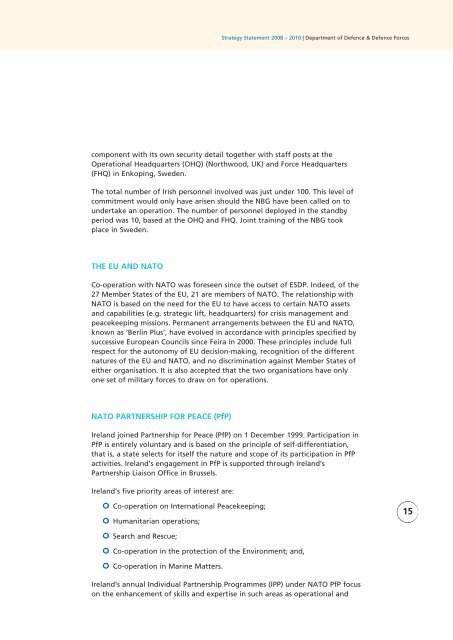Strategy Statement 2008 - 2010 - Department of Defence
Strategy Statement 2008 - 2010 - Department of Defence
Strategy Statement 2008 - 2010 - Department of Defence
Create successful ePaper yourself
Turn your PDF publications into a flip-book with our unique Google optimized e-Paper software.
<strong>Strategy</strong> <strong>Statement</strong> <strong>2008</strong> – <strong>2010</strong> | <strong>Department</strong> <strong>of</strong> <strong>Defence</strong> & <strong>Defence</strong> Forces<br />
component with its own security detail together with staff posts at the<br />
Operational Headquarters (OHQ) (Northwood, UK) and Force Headquarters<br />
(FHQ) in Enkoping, Sweden.<br />
The total number <strong>of</strong> Irish personnel involved was just under 100. This level <strong>of</strong><br />
commitment would only have arisen should the NBG have been called on to<br />
undertake an operation. The number <strong>of</strong> personnel deployed in the standby<br />
period was 10, based at the OHQ and FHQ. Joint training <strong>of</strong> the NBG took<br />
place in Sweden.<br />
THE EU AND NATO<br />
Co-operation with NATO was foreseen since the outset <strong>of</strong> ESDP. Indeed, <strong>of</strong> the<br />
27 Member States <strong>of</strong> the EU, 21 are members <strong>of</strong> NATO. The relationship with<br />
NATO is based on the need for the EU to have access to certain NATO assets<br />
and capabilities (e.g. strategic lift, headquarters) for crisis management and<br />
peacekeeping missions. Permanent arrangements between the EU and NATO,<br />
known as ‘Berlin Plus’, have evolved in accordance with principles specified by<br />
successive European Councils since Feira in 2000. These principles include full<br />
respect for the autonomy <strong>of</strong> EU decision-making, recognition <strong>of</strong> the different<br />
natures <strong>of</strong> the EU and NATO, and no discrimination against Member States <strong>of</strong><br />
either organisation. It is also accepted that the two organisations have only<br />
one set <strong>of</strong> military forces to draw on for operations.<br />
NATO PARTNERSHIP FOR PEACE (PfP)<br />
Ireland joined Partnership for Peace (PfP) on 1 December 1999. Participation in<br />
PfP is entirely voluntary and is based on the principle <strong>of</strong> self-differentiation,<br />
that is, a state selects for itself the nature and scope <strong>of</strong> its participation in PfP<br />
activities. Ireland’s engagement in PfP is supported through Ireland’s<br />
Partnership Liaison Office in Brussels.<br />
Ireland’s five priority areas <strong>of</strong> interest are:<br />
Co-operation on International Peacekeeping;<br />
Humanitarian operations;<br />
15<br />
Search and Rescue;<br />
Co-operation in the protection <strong>of</strong> the Environment; and,<br />
Co-operation in Marine Matters.<br />
Ireland’s annual Individual Partnership Programmes (IPP) under NATO PfP focus<br />
on the enhancement <strong>of</strong> skills and expertise in such areas as operational and
















